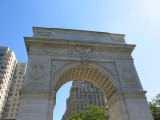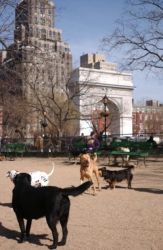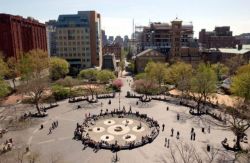Washington Square Park
View all monuments in NYC Parks, as well as temporary public art installations on our NYC Public Art Map and Guide.
Washington Square Arch
| Artist: | F.W. MacMonnies, spandrel figures Philip Martiny, eagles Hermon Atkins MacNeil (Washington as Commander) Alexander Stirling Calder (Washington as President) Piccirilli Brothers (Carvers) |
| Dedicated: | May 4, 1895 |
Artwork History
What is this monument dedicated to?
This triumphal arch honors George Washington (1732-1799), first president of the United States, and the democratic principles he espoused. A temporary arch of wood and plaster was first placed in 1889 north of the park in honor of a citywide celebration of the centennial of Washington’s inauguration in New York City. The arch is also an expression of the City Beautiful movement, whose proponents sought to create civic structures and public spaces in America whose beauty and stature would rival those of European capitals.
How was this created?
The temporary arch was so successful that a citizens committee soon formed to raise funds to commission this permanent arch. Noted architect Stanford White (1853-1906), designed the structure, made principally of Tuckahoe marble. Foundations were laid in May 1890 by David H. King Jr., the well-known builder of the Statue of Liberty’s pedestal, and the cornerstone (concealing a copper time capsule) was laid on “Decoration Day,” May 30, 1890. The grand dedication, slated for April 30, 1895 (to coincide with the anniversary of Washington’s inauguration) was postponed due to torrential rains, and happened instead on May 4.
Taking inspiration from Roman triumphal arches, White’s design serves as a portal between the park and the city at the southern terminus of Fifth Avenue. Eagles surmounting the north and south keystones are by sculptor Philip Martiny and graceful spandrel figures by Frederick MacMonnies represent Peace, War, Fame and Prosperity. Decorative and symbolic trophy panels were designed by McKim, Mead and White.
The initial monument campaign financed pedestals on the north façade to receive statuary (of Dover marble) that would not be completed until World War I. The eastern figure by Hermon Atkins McNeil installed in 1916 depicts Washington as Commander-in Chief, accompanied by Fame and Valor. The western figure, installed in 1918 was made by Alexander Stirling Calder (father of the famous mobilist) and represents Washington as President, accompanied by Wisdom and Justice. Principal carvers of the statuary and ornamentation were the Piccirilli Brothers, a family of master carvers from Italy who established a studio in the Bronx. A quotation engraved on the south parapet below the cornice is from Washington’s speech to the Constitutional Convention held in Philadelphia in 1787: “Let us raise a standard to which the wise and honest can repair. The event is in the hands of God.”
For more than 65 years traffic ran through and around the Arch. The effects of pollution and acid rain eroded the fragile marble, and an ill-advised cleaning contract in 1966 further damaged the main statuary. Water plagued the structure, undermining its structural integrity and it was fenced off for many years. In 2004, the arch was rededicated after a city capital restoration. The restoration included repointing and repairing all masonry, re-carving damaged or missing sculptural and decorative features. Additionally, 45 of the 95 rosettes on the coffered soffit of the arch were repaired or replaced in color-matched cast concrete. The restoration’s final phase included the installation of extensive architectural lighting and bird netting. Since then, annual inspections and a regular regimen of care have helped preserve this magnificent monument as a symbol of democracy and resilience, that remains a recognizable worldwide landmark.
Artwork Details
| Description: | Triumphal arch, with two eagles, spandrel figures, two pier sculptures |
| Architect: | Stanford White (arch); McKim, Mead and White (trophy panels) |
| Materials: | Tuckahoe marble |
| Dimensions: | H: 73'6" W:56'10"; Span 30' |
| Donor: | Public subscription |
| Cast: | 1895 |
Inscription
South-facing side (attic): "LET US RAISE A STANDARD TO WHICH THE WISE AND HONEST CAN REPAIR / THE EVENT IS IN THE HAND OF GOD /-WASHINGTON"
North-facing side (attic): "TO COMMEMORATE THE ONE HUNDREDTH ANNIVERSARY OF THE INAUGURATION OF GEORGE WASHINGTON AS FIRST PRESIDENT OF THE UNITED STATES"
Please note, the NAME field includes a primary designation as well as alternate namingsoften in common or popular usage. The DEDICATED field refers to the most recent dedication, most often, butnot necessarily the original dedication date. If the monument did not have a formal dedication, the yearlisted reflects the date of installation.
For more information, please contact Art & Antiquities at (212) 360-8163.
Check out your park's Vital Signs
Clean & Safe
Green & Resilient
Empowered & Engaged Users
Share your feedback or learn more about how this park is part of a
Vital Park System























